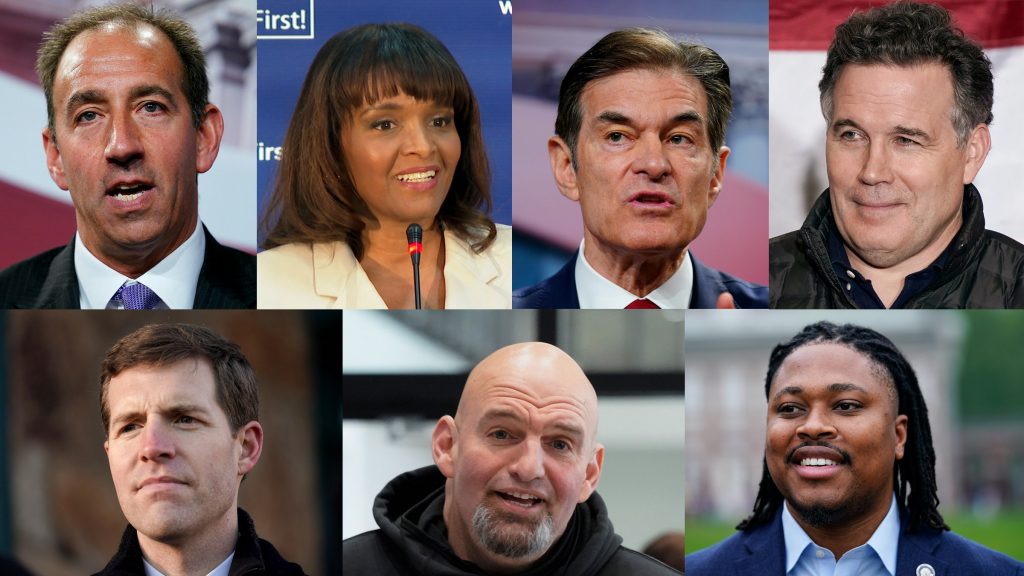Tuesday’s crowded Pa. primary sets the stage for a November election that could alter the balance in Washington.
by Lizzy McLellan Ravitch | Originally posted on May. 15, 2022, to BILLYPENN HERE.
Photo: Higher profile candidates for U.S. Senate in Pa, clockwise from top left: Jeff Bartos (R), Kathy Barnette (R), Mehmet Oz (R), Dave McCormick (R), Malcolm Kenyatta (D), John Fetterman (D), Conor Lamb (D) AP PHOTO
As midterm elections approach, the national spotlight is once again on Pennsylvania.
The U.S. Senate is currently split down the middle with 50 Republicans and 50 Democrats, and several races across the country are close enough for one of the major parties to net a seat or two, giving them the majority.
Political observers agree that Pennsylvania so far is the most interesting Senate race to watch.
It’s a wide open seat, because incumbent Republican Sen. Pat Toomey decided not to run for reelection. Four Democrats and six Republicans are running in the primary. Many have nontraditional political resumes for a U.S. Senator, or little to no experience running a statewide campaign — or both. (See more about the candidates here).
While political science experts are watching Pennsylvania closely, Pennsylvanians on average are far less plugged in, and less likely to vote. Turnout for midterm elections consistently lags presidential elections throughout the U.S.
“To the average voter… who votes in the presidential election and doesn’t vote every six months, there’s not a clear understanding of the importance of this election,” said Abu Edwards, a political consultant and political action chair of NAACP Philadelphia chapter.
A polarized state in a polarized country
There are seven open Senate seats in the 2022 midterms, where no incumbent is running. Of those, three are in swing states where a Republican senator is retiring: Pennsylvania, North Carolina and Ohio.
Of those three, Pennsylvania is the most likely to elect a Democrat, referred to as a flip. North Carolina and Ohio both went for Trump in 2020, but Biden won in Pennsylvania. Historically, the president’s party tends to be disadvantaged in midterm elections, so it’s not going to be easy for Democrats, but Pennsylvania is their best bet.
In addition to the open races, there are several states where incumbents are facing a challenge to keep their seats in the Senate. Predicting each party’s odds in the general election is difficult until each state holds its primary election, some of which aren’t until August. Still, Pennsylvania is seen as a key battleground.
“The race in November, for people outside Pennsylvania, will be seen as one of a suite of must-win races for the Democrats,” said Sarah Binder, a political science professor at George Washington University and a fellow at The Brookings Institution.
“It is a pivotal race for control of the Senate,” Binder said. And the results will also be a signal for the presidential race in 2024, given Pennsylvania’s recent history as a “purple” state.
The U.S. is in the midst of a decades-long streak where neither party has 60 or more seats in the Senate, noted Stephen Medvic, a government professor at Franklin & Marshall College in Lancaster. In this political climate, every race matters, he said.
“It’s part of what’s fueling the intense polarization. Every single move that gets made is thought to be determinative of who is going to control national politics,” Medvic said.
Pennsylvania’s political landscape has the same divided dynamic. Because of that, the primaries also matter a lot..
“The nominees can really make a difference [in the general election result] either because they don’t appeal to swing voters or they’re not exciting to their party’s base,” Medvic explained.
The Republican primary is particularly interesting to election watchers because it serves as “a microcosm of the differences in the Republican party” across the U.S., Binder said. The possible Republican nominees haven’t been “vetted” in prior races, so “surprises are more likely along the way,” she added.
Politicos will also be watching the Republican ticket as an indicator of how strongly Donald Trump’s endorsement aligns with victory in the GOP.
“This is one of the races in which former President Trump is trying to flex his muscle and be the kingmaker in the country,” noted Peter Montgomery, a fellow at thinktank People for the American Way, who studies the Religious Right.
Trump has endorsed celebrity doctor Mehmet Oz to be Pa.’s next senator.
On Thursday, after conservative commentator Kathy Barnette surged in the polls, Trump made an anti-endorsement, warning voters against choosing her in the primary, saying “Kathy Barnette will never be able to win the General Election against the Radical Left Democrats.” But he also said he would back her in the general election if she becomes the nominee.
The abortion debate is likely to be a top motivator for voters this year, experts agreed, but less so in the primary. Still, they expect the issue to continue capturing voters’ leading up to November.
“A lot of people that didn’t closely follow politics didn’t believe the court would just take away a right that’s been in place for 50 years,” Montgomery said. “It’s going to be a real wake-up call to a lot of people.”
Democrats will look to keep it top of mind. Senators took a vote on May 11 to move forward with a federal law that would preserve abortion rights even if the Supreme Court overturns Roe. It wasn’t expected to pass — with one Democrat and every Republican voting no — much like the last time senators voted on it in February. “I think it’s really important to have this vote to show where everyone stands,” Democratic Sen. Amy Klobuchar of Minnesota told NPR.
Lesson in Georgia: The power of voter turnout
The last time Americans honed in on one state’s U.S. Senate race was last year in Georgia.
It was a highly unusual election, in that it took place in January 2021 as a runoff for both of the state’s seats. Democrats Jon Ossoff and Raphael Warnock emerged as winners, defeating two Republican incumbents.
“A lot of people did not expect Sen. Warnock and Sen. Osoff to win those races,” said Montgomery, of the People for the American Way. It happened, he said, because “organizers on the ground stayed focused on convincing people that coming out to vote is important.”
Both senators in that race raised more money than any other congressional candidates in history.
Turnout in the Georgia runoff shattered records, with 90% of voters who came out for the presidential election casting a ballot for the Senate race two months later. For comparison, the most recent previous Senate runoff, in 2009, brought out just 57% of presidential election voters.
Like Georgia electing two Democrats in 2021, Pennsylvania would be bucking the norm by electing a second Democrat to the Senate this fall.
Pennsylvania had two Democrats in the Senate for a brief period at the beginning of the Barack Obama presidency — Bob Casey and Arlen Specter — but it’s not because voters elected two Dems. Specter was a Republican for most of his decades-long political career. In 2009, at Obama’s urging, he switched parties. He then lost in the subsequent primary in 2010. Before that, you have to go back to 1945 to find a time when Pennsylvania had two Democratic senators — Joseph Guffey and Francis Myers — and it lasted for only two years.
Republicans, on the other hand, have held both of Pennsylvania’s Senate seats many times — both seats were red for more than 90 of the last 120 years. But the most recent stretch was 15 years ago, when Rick Santorum was in office from 1995 to 2007, alongside Specter.
Roughly 80% of Democrats and Republicans will vote for their party’s nominee every time, according to Medvic, the Franklin & Marshall professor, and even independents tend to have a preferred party they usually stick with. “The other thing is turnout,” he added.
Edwards, of NAACP Philadelphia, said the focus of his organization is helping the average voter, who only votes every four years, to understand the importance of midterms and come out to vote more often.
Turnout may be low in this week’s primary, he said. However it shakes out, he hopes to use that information to shape voter mobilization strategies with other organizations leading up to the general election.
“Voting is not like a driver’s license, which is a privilege,” Edwards said. “It’s something that makes us part of society and it shouldn’t be taken away from us.”

